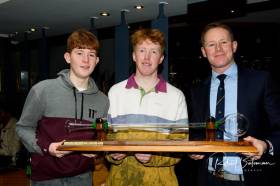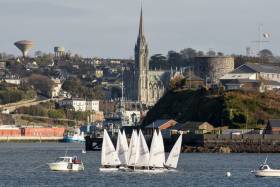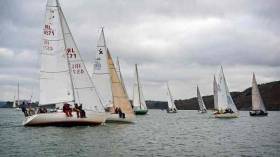Displaying items by tag: Monkstown Bay Sailing Club
Laser Sailor Wins at Monkstown Bay Dinghy League in Cork Harbour
Monkstown Bay Sailing Club’s October Cork Harbour dinghy league ended with Class 1 top place going to Laser sailor Ronan Kenneally. He had a total of 8 points from six races, winning two, second in three, discarding one placing. He was two points ahead of an RS400 and a GP14.
Sandy Rimmington and Richie Harrington in the RS 400 and Alex Barry and Ken Murphy in the GP finished on 10 points.
This resulted in a ‘tie-breaker’ where each race result throughout the series is taken into account. The RS200 crew had two firsts, a second and two thirds. The GP 14 sailors also had two firsts. They counted two thirds, but had one fourth, which cost them second place, pushing them to third overall.
In Class 2 Harry Pritchard sailing his Laser was well ahead overall, finishing on six points from eight races, seven of which he won and finished second in the other. It was a strong performance by the young sailor. Two Topper sailors were next. Cian McDonagh was second on 19 points and Frances Corkery third on 20.
Cork Laser Dinghy League Winners Decided at Monkstown Bay
Saturday, February 16th saw the Laser sailors of Cork gather for the final day of the Monkstown Laser Frostbite League, sponsored by CH Marine writes Chris Bateman.
The morning began with a mixed sky over the bay. Patches of blue were seen in amongst ominous-looking clouds. A fresh breeze blew from the south, whistling through shrouds on the Sandquay. The bay looked inviting; a dark blue in colour and a slight chop disturbing the water.
The sailors arrived in Monkstown as early as ever. Sails were heard before they were seen, flogging in the strong wind. Without delay, Race Officer Alan Fehily set a windward/leeward course at the entrance to Monkstown Creek. Raring to go, the competitors took to the waters in record time.
The sequence began for race one at 10:15am, the exact scheduled time. Ten sailors worked hard to hold their positions on the line until the gun went. It was a clean start and the dinghies were seen battling their way up the course. The breeze was shifty, threatening to knock the sailors over with every gust. It was all they could do to stay upright and they had to sail carefully for three rounds. Sundays Well sailor Paul O’Sullivan stayed ahead of the fleet for the majority of the race, holding off MBSC sailors Rob Howe and Ronan Kenneally. O’ Sullivan took first place, with Howe close behind in second. Kenneally followed up in third place.
In the radial category, MBSC’s Harry Pritchard was the only one to test the conditions. He sailed fast, mixing it in with the bigger standard rig sailors.
The second race was challenging, with gusts of 25 knots hitting the water. The conditions were typical for Monkstown Bay; holes in the wind and a strong flood tide dominated the course. Paths were picked carefully and it was all but decided at the finish line. Kenneally sailed well and took first place, just in front of Howe who finished second. MBSC’s William O’Brien finished close behind in third place.
The third and final race of the league began in a more constant wind, averaging roughly 15 knots down the course. It was close racing off the start line and all the sailors tussled up to the windward mark. Kenneally took the lead early and fought to hold his position. O’Brien was in hot pursuit, contesting the laser ace. Howe sailed close behind, carefully covering the fleet.
Kenneally crossed the finish line in first, winning the last race of the league. O’Brien followed in second, with Howe close behind in third place.
The final race concluded and the sailors went ashore. A prizegiving was scheduled for 12:30pm and all the competitors looked forward to the warmth of the Bosun. Eighteen races had not been sailed for nothing; all of the sailors had raced in earnest for the prestigious Yard of Ale trophy, over six cold Saturdays. In the end, MBSC sailors dominated the top four positions. Former UK Laser Olympic squad member Rob Howe finished in fourth position. In third position was the well-known avid National 18 sailor Charles Dwyer. In second place was the two-time Monkstown laser frostbite league winner Ronan Kenneally. The winner of the Yard of Ale trophy was your correspondent, who finished just a point ahead of Kenneally.
In the radial category, Harry Pritchard from MBSC finished in first position; he was also the first person to win in this category. He sailed well and by the end of the league he had lots of race wins under his belt.
All scheduled races had been sailed and it was in high spirits the competitors left the Bosun, ready to enjoy another season of laser sailing. Rest assured they will be the first to start next year’s season, at the next Monkstown Laser frostbite league.
Photos below by Bob Bateman
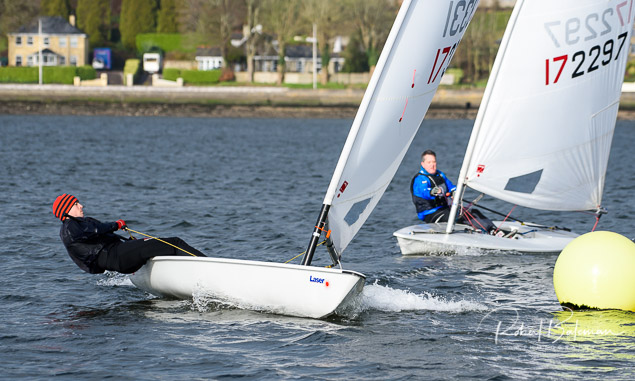 Brendan Dwyer (foreground) Photo: Bob Bateman
Brendan Dwyer (foreground) Photo: Bob Bateman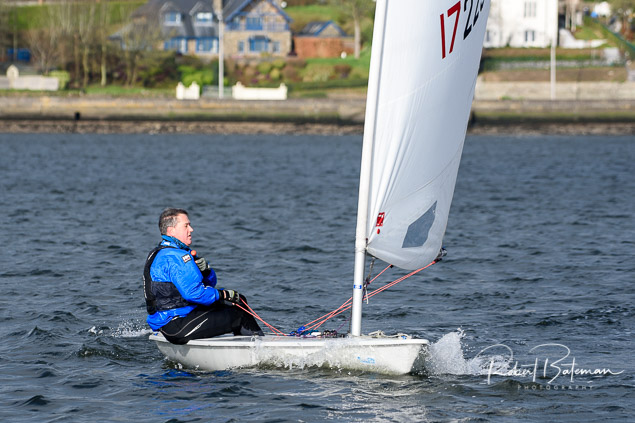 Rob Howe Photo: Bob Bateman
Rob Howe Photo: Bob Bateman Paul O'Sullivan (foreground) Photo: Bob Bateman
Paul O'Sullivan (foreground) Photo: Bob Bateman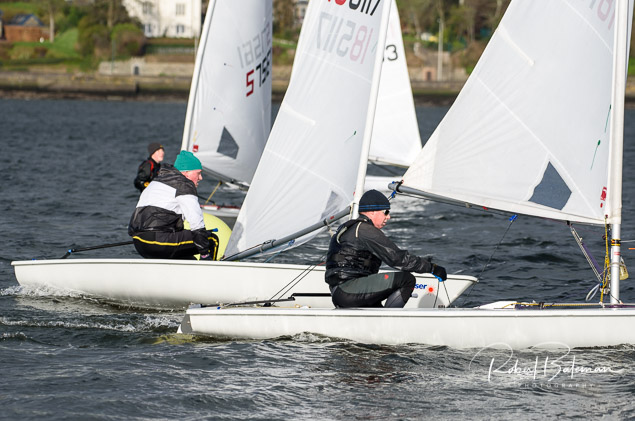 James long (foreground) and William O'Brien (background) Photo: Bob Bateman
James long (foreground) and William O'Brien (background) Photo: Bob Bateman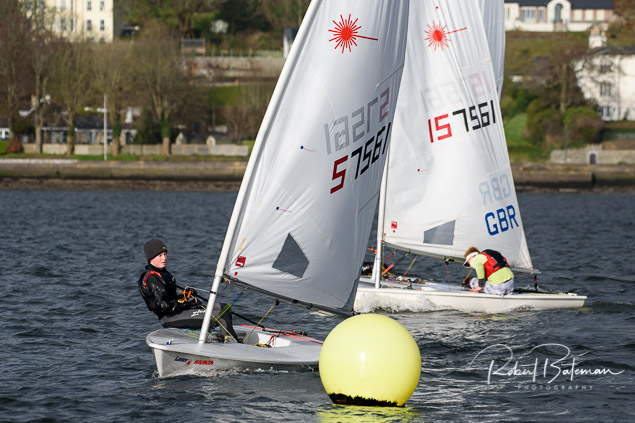 Harry Pritchard Photo: Bob Bateman
Harry Pritchard Photo: Bob Bateman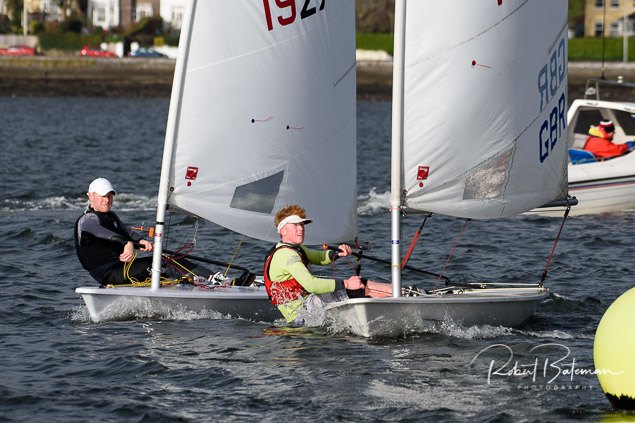 Ronan Kenneally (left) And Chris Bateman Photo: Bob Bateman
Ronan Kenneally (left) And Chris Bateman Photo: Bob Bateman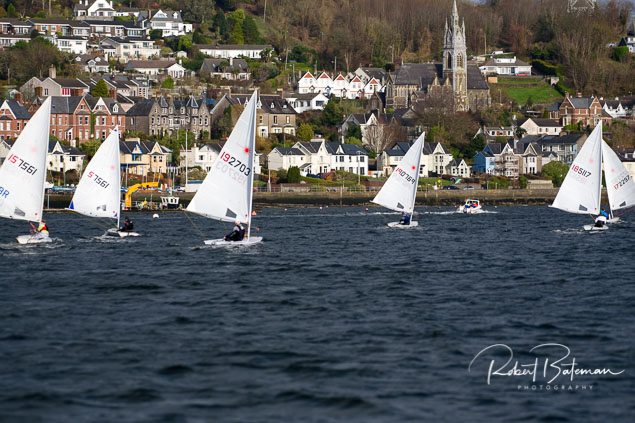 Tight downwind on Monkstown Bay Photo: Bob Bateman
Tight downwind on Monkstown Bay Photo: Bob Bateman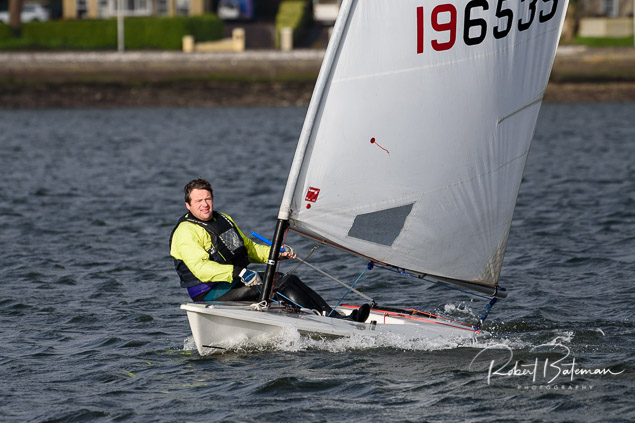 Rob Bateman Photo: Bob Bateman
Rob Bateman Photo: Bob Bateman Chris Bateman Photo: Bob Bateman
Chris Bateman Photo: Bob Bateman Paul O'Sullivan bears away in a gust Photo: Bob Bateman
Paul O'Sullivan bears away in a gust Photo: Bob Bateman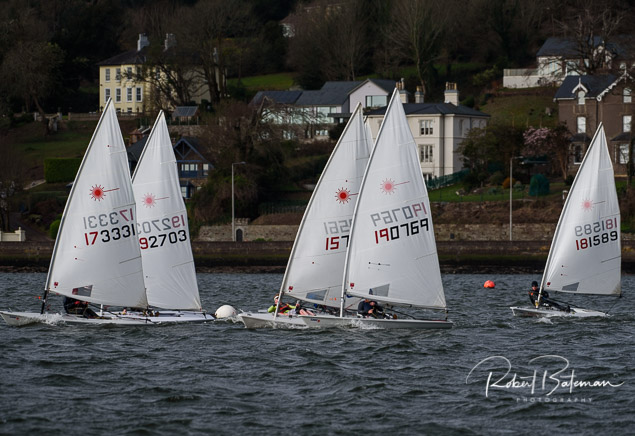 The Lasers get a clean start Photo: Bob Bateman
The Lasers get a clean start Photo: Bob Bateman Ronan Kenneally (left) second in the standard fleet and Harry Pritchard radial winner Photo: Bob Bateman
Ronan Kenneally (left) second in the standard fleet and Harry Pritchard radial winner Photo: Bob Bateman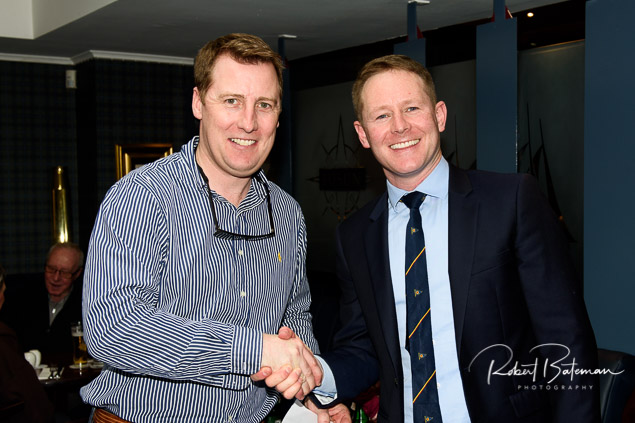
 Chris Bateman with the MBSC Yard of Ale trophy Photo: Bob Bateman
Chris Bateman with the MBSC Yard of Ale trophy Photo: Bob Bateman
Saturday, February 2nd saw laser sailors competing on Monkstown Bay in Cork Harbour for the fourth day of the Monkstown Laser Frostbite League, sponsored by CH Marine writes Chris Bateman.
The morning began with a golden sunrise overlooking the eastern end of the bay. Beautiful beams of light reflected on the glassy water but alas not a breath of wind was in the air. A canvas of cloudless blue sky gave no signs of breeze.
Sub Zero temperatures were in store for the competitors. Regardless of the cold, twelve enthusiastic sailors arrived at the Sand quay bright and early to prepare for the mornings racing. Ice ridden covers were separated from the decks and ropes were unstuck from cockpit floors.
 The sailors feathered their way around Monkstown Bay in light wind Photo: Bob Bateman
The sailors feathered their way around Monkstown Bay in light wind Photo: Bob Bateman
One by one the sailors launched into the glassy waters. As the hustle and bustle of rigging diminished, a light breeze filled in from the north-west. Race officer Alan Fehily sprung into action, setting a windward/leeward course off Blackpoint.
The start sequence for the first race began right on time at 10:15 am. The competitors lined up, holding their positions until the gun went. The race began and it was an immediate search for clear breeze. The wind was uncertain, shifting through 30 degrees and occasionally easing away to nothing. The sailors persevered, suffering big gains and losses. MBSC sailors Charles Dwyer and Rob Howe led the race from the windward mark. However, on the first downwind leg the boats behind got hit by a gust of wind and overtook the leaders. For the rest of the race, MBSC’s Ronan Kenneally led the pack, with Paul O’Sullivan and William O’Brien in close pursuit. Local Monkstown sailors William O’Brien and your correspondent overtook Kenneally on the last downwind leg. Bateman finished in first with O’Brien close behind in second. Kenneally finished in third place right behind O’Brien.
 Laser racing on Monkstown Bay Photo: Chris Bateman
Laser racing on Monkstown Bay Photo: Chris Bateman
In the Radial fleet, MBSC’s Harry Pritchard sailed fast and was heavily contesting the standard fleet. He finished in first place, staying ahead of RCYC’s Sophie Crosbie and Innascarra’s Robert McGarvey.
The competitors had every confidence in the wind for the second race of the day. A settled eight-knot breeze blew down the course. A strong flood tide swept up the bay, giving the sailors cause for concern as they made their way to the windward mark. The competitors were careful to avoid two sizeable container ships passing through the course on each downwind leg. Howe and Bateman led the fleet, holding their positions for the majority of the race. Bateman finished in first, with Howe right behind in second. Sundays Well SC sailor Paul O’Sullivan crossed the line in a close third place.
In the Radial fleet, Harry Pritchard held his lead to finish in first position.
"In a nail-biting finish, your correspondent took first place"
The last race of the day began in a solid ten knots with gusts of up to fifteen. Kenneally led the race from the start and rounded the mark in front of O’Brien and Howe. Kenneally held his lead until the last downwind leg, where he battled it out with Bateman. In a nail-biting finish, your correspondent took first place with Kenneally finishing no less than a metre away. Howe sailed across the finish line to secure third position.
In the Radial fleet, RCYC’s Sophie Crosbie finished in first place, holding off Pritchard and McGarvey for the majority of the race.
Despite the difficult conditions, three successful races were completed. All of the sailors had braved the cold. Arriving ashore, the sailors put their boats to bed and tucked them away on the Sand quay, where they would be taken out once again for next weekend's racing.
Kinsale Laser Ace Crowned with Yard of Ale at Monkstown Bay Sailing Club
A westerly wind of ten knots brought Monkstown Bay Sailing Club's Laser League to a conclusion on Saturday writes Bob Bateman.
Kinsale's Darragh O'Sullivan, who did not contest the final races of the series, was very much in evidence at the prizegiving to lift the coveted 'Yard of Ale' trophy that has been fought over 18 races in Cork Harbour.
Chris Bateman was second overall and first Junior. Ronan Kenneally was first Master and third overall.
Full results below

Kinsale Yacht Club's Laser Sailor Darragh O'Sullivan is on Course For Yard of Ale Prize
Another three race wins at the Monkstown Bay Sailing Club Laser League in Cork Harbour on Saturday means Kinsale Yacht Club's Darragh O'Sullivan has it all sewn up before the final race and he'll claim the traditional 'Yard of Ale' first prize next weekend writes Bob Bateman.
A bitingly cold, and gusty north-west wind and a strong ebb tide greeted a somewhat depleted fleet that saw local Chris Bateman maintained second place. Third overall is Ronan Kenneally.
Results below after 15 races.
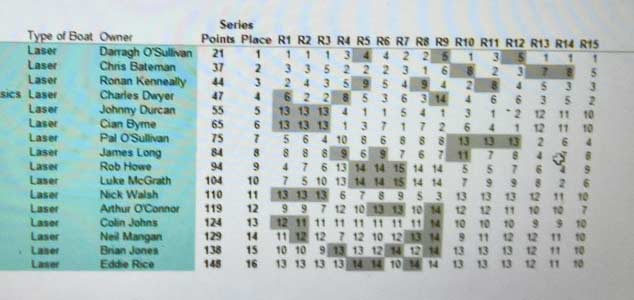
O'Sullivan Stays Ahead at Monkstown Bay Sailing Club Laser Frostbite Series in Cork Harbour
Three different competitors got the winning gun in today's short sharp races at Monkstown Bay Sailing Club Laser Frostbite Series in Cork Harbour but Darragh O'Sullivan is still holding the overall lead writes Bob Bateman.
Chris Bateman is three points behind in second overall with John Durcan just a point further behind.
It was mild day, if a bit overcast, with a ten–knot west–south–west breeze greeting the competitors for the fourth day of racing with Alan Feehily doing the honours as PRO.
Racing continues next week.
Photo gallery below
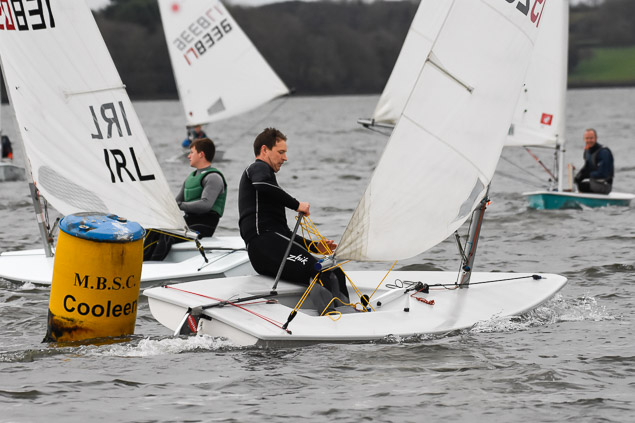 Above and two photos below: Charles Dwyer is sixth overall
Above and two photos below: Charles Dwyer is sixth overall
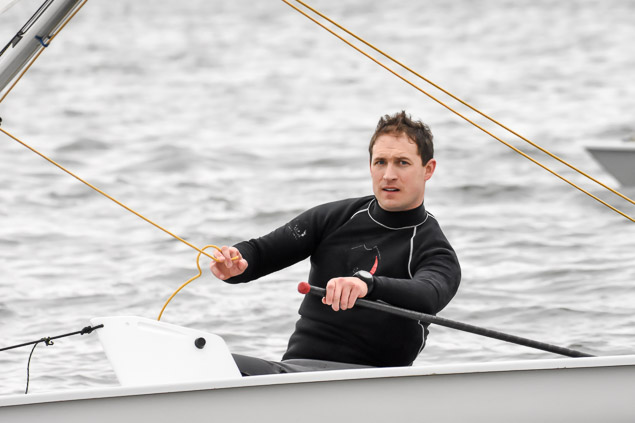
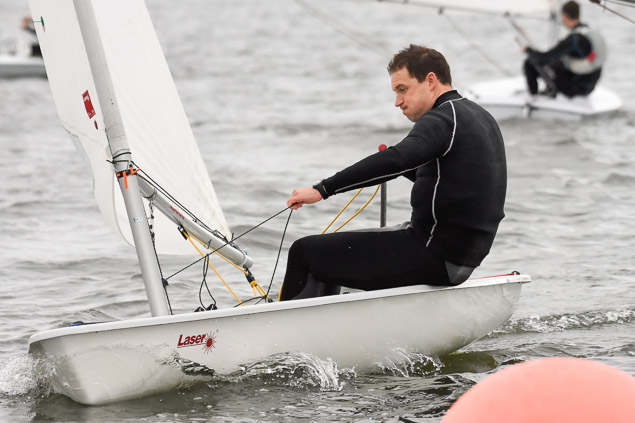
 Chris Bateman is three points off the lead
Chris Bateman is three points off the lead
 Arthur O'Connor is 12th overall
Arthur O'Connor is 12th overall
 Above and two photos below: Johnny Durcan is third overall
Above and two photos below: Johnny Durcan is third overall
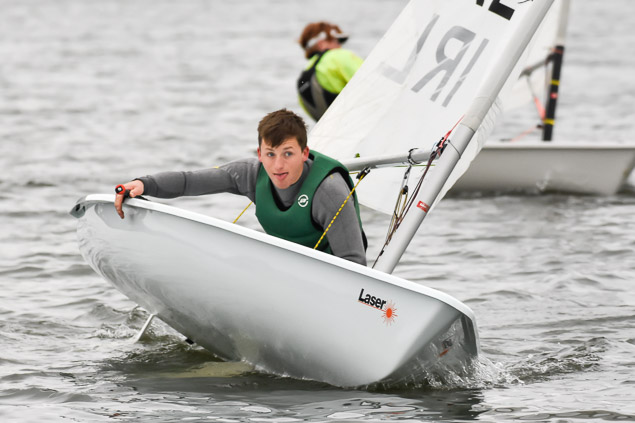
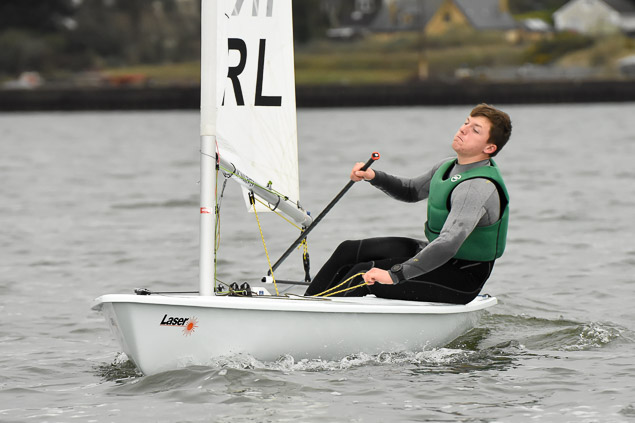
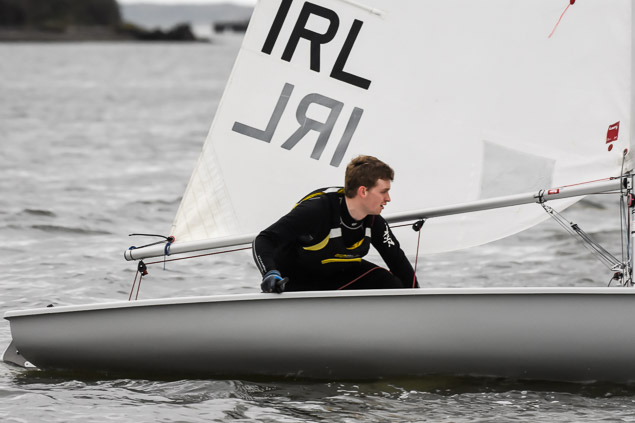 Above and below Cian Byrne is fourth overall
Above and below Cian Byrne is fourth overall
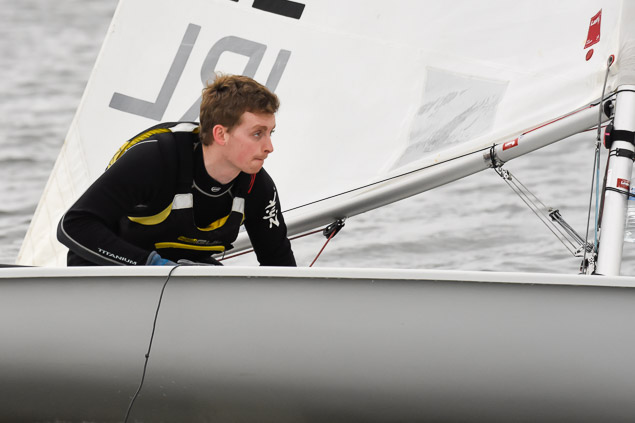
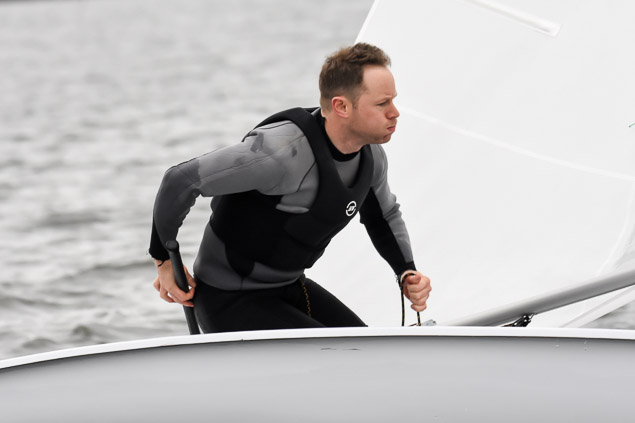 Last year's league winner Ronan Kenneally is fifth overall
Last year's league winner Ronan Kenneally is fifth overall
 Rob Howe lies ninth
Rob Howe lies ninth
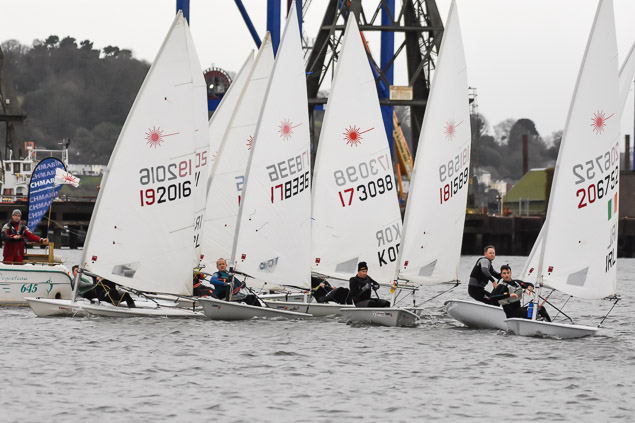 Tight mark roundings in the Monkstown Bay Laser dinghy league
Tight mark roundings in the Monkstown Bay Laser dinghy league

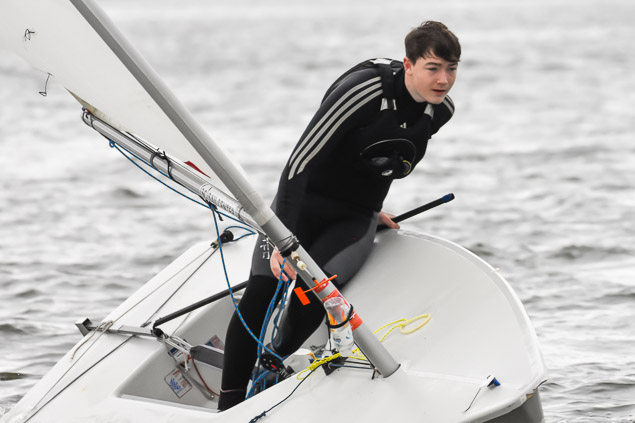 Luke McGrath
Luke McGrath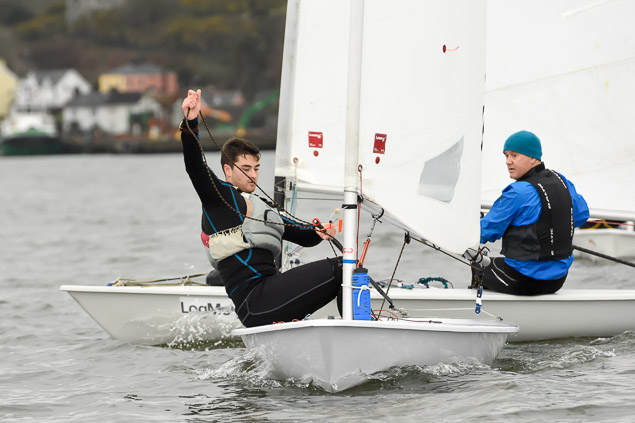 O'Sullivan leads Howe into a weather mark
O'Sullivan leads Howe into a weather mark
 Overall results after 12 races so far
Overall results after 12 races so far
Monkstown Bay SC Laser Winter Series Returns For 2018
#Laser - Following on from the success of recent years, the Monkstown Bay Sailing Club Laser Winter League returns in January 2018.
Running every Saturday from 6 January to 10 February, three short races will be held per day with the first gun/boat start at 10.15am, as close as possible to the sand quay, and with all boats ashore by noon.
The entry fee is €20 per boat to cover costs of fuel and prizes.
After hosting as many as 18 full rigs in Cork Harbour last season, and with 15 boats already entered, the club is hoping to top that number in the New Year — as well as give the Howth YC Frostbites some serious competition across the country.
If you know of anyone interested, Monkstown Bay SC would love to have them out. Contact Charles Dwyer at 086 170 3289 or [email protected].
Cork Harbour Sailing Clubs Join Forces to Develop Cruiser Racing
Monkstown Bay and Cove Sailing Clubs have agreed a joint cruiser racing programme for this season which will set a new course in Cork harbour sailing, writes Afloat's Tom MacSweeney in the Evening Echo.
The neighbouring clubs have been in discussion for some time with the aim of engaging in joint racing. Like clubs around the country, it has been proving difficult to maintain cruiser racing, so getting together for inter-club racing is a way forward in strengthening interest in the sport.
Monkstown Bay SC cruisers concentrate on white sail racing while Cove has both white sail and spinnaker classes.
Both have agreed a series of inter-club white sail events, when cruisers from both will race together. They will also run their own club sailing programmes, so this could be the ‘best of both worlds’ for the sailors. It is a positive development, one to be welcomed in bringing clubs in Cork Harbour together.
While there may be some adjustments to the schedule as the season progresses, which can invariably happen with the best-laid plans, the agreed approach involves both clubs joining forces on Sunday May 21 and Saturday, May 27, starting together on the Cove SC line. Monkstown will, in the same month run its own weekly Thursday night league. Cove will launch its sailing programme with a formal announcement of the season’s plans on May 5.
On Saturday, June 3, the June Bank Holiday Weekend both clubs will race in Monkstown which will also be the Sea Hennessy Trophy for Monkstown boats, to honour that village’s much-revered sailor, the late Charlie Hennessy. The clubs will gather together again in Cobh on four Fridays in June – 9, 16, 23 and 30. A race to Kinsale, which will also be a ‘feeder’ for the Sovereign’s Cup there, is planned on Saturday, June 17. For boats not racing in the Cup series, this will be an overnight occasion, with a race back to Cork Harbour the following day.
In July Monkstown will hold its ‘At Home Regatta’ on Saturday, July 8, which SCORA, the South Coast Offshore Racing Association, is expected to support and on Saturdays, July 15, 22, 29, Cove will join MBSC in racing at Monkstown. On Sunday, July 23 racing will be in Cove.
August is generally the month when boats head West for holiday cruising, so no joint racing is planned, but they will gather again in September. On Saturday, September 2, the Ballinacurra Race will start from Cove and finish in East Ferry. Saturday, September 9, is the date scheduled for the annual Cobh-to-Blackrock Race and there are joint MBSC and Cove SC events planned on Saturdays September 16, 23 and 30.
Hopefully, this inter-club initiative will boost cruiser racing in Cork Harbour.
Monkstown Bay Sailing Club Laser Sailor Wins 'Yard of Ale' in Cork Harbour Racing
A ‘Yard of Ale’ - the “famous trophy” - as the Laser sailors described it was presented to Ronan Kenneally at Monkstown Bay Sailing Club in Cork Harbour where he won the Winter League for the second year running as reported this evening by Tom MacSweeney in the Evening Echo
Freezing temperatures and a chilly Northerly wind arrived as forecasters predicted when the dinghy sailors gathered on the Sand Quay at Monkstown for the final day of the CH Marine League which had 19 entries. Race Officer, Colin Barry, on board committee vessel "Kiawah”, set a course from Monkstown Creek back up to Monkstown's Sand Quay. Cork Harbour Marina’s physical presence and a strong ebb tide meant the battle for first place was won by whoever could stay closest to shore. The 12-15 knots of breeze under clear skies made it a testing closure to the series.
Heavy-air ‘specialists’ were dominant, with former Great Britain Laser Squad sailor Rob Howe back on the leaderboard, having two firsts as the morning racing proceeded. Nick Walsh also revelled in the conditions, claiming a first place in the second race. Charles Dwyer was first in Race 3. Strong gusts in the windy conditions caused some competitors to have spectacular capsizes into the icy the waters of Monkstown Bay.
By the end of racing Ronan Kenneally, who had led the league throughout the series, did enough to maintain that position and win overall for the second year in succession. Nick Walsh placed second, Charles Dwyer third and Rob Howe finished fourth overall.
Cork Harbour Dinghy Sailors Go Cold Water Sailing
It was ice on the rigging which put me off sailing in November and December. That was quite a few years ago, but as climate change has had its effects, those months have had different weather patterns and this year the November/December Cruiser League in Cork Harbour was well supported.
But racing in a cruiser is different to having your rear end very close to the water … as it can be in a Laser dinghy …So as the cold of January made itself known in a few bitter mornings this week across Cork Harbour, when frost glistened on cars and roads and patterned the covers of dinghies on the Sand Quay in my local village of Monkstown I admit to marvelling at the determination of those Laser sailors who have entered for the second year of the Winter League at Monkstown Bay Sailing Club.
What is the attraction of sailing at this time of year? Listen to the podcast with Charles Dwyer below:
That’s the Laser League organiser, Charles Dwyer at Monkstown Bay and he has an entry of 15 already which, he says “is getting close to the numbers they achieve in Howth’s Frostbites, surely we can beat the Dubs….!”
Saturday will tell, when the League starts and runs until the first of February…. First gun is definitely at 10,15 a.m. at a boat start close to the Sand Quay… and sailors will be back ashore by noon…. And Charles wants more boats…. €20 entry fee …..Showers and soup provided. “Just rock up on Saturday morning and join us at the Sand Quay in Monkstown…... “… That’s what he says…. As I said,….. I stopped frostbite sailing…. I’m prepared to leave it to the Lasers…. And I’m sure they’ll do it well..





























